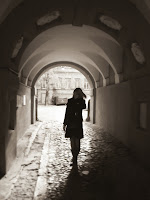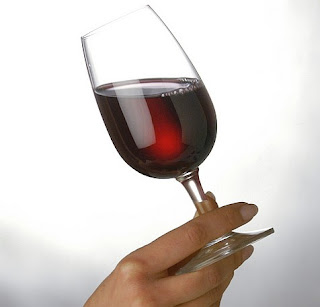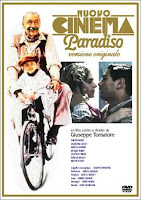
But time has designs of its own. It has sought to destroy some and gently wear away at others. Some tiles that were lost could not be replaced. In such places, rather than remove all the tiles and start again, the owners of the buildings simply replaced them with other tiles. This has created a complex patchwork, all the more beautiful for the story it tells.
And although the buildings' owners do the best they can, perhaps time is the real architect. Portuguese tiles, known as azulejos, adorn the inside and outside of almost every home in Portugal. Although introduced to Iberia by Moors, the fashion continued after they left.

Portuguese and Flemish artists began to produce tiles in Lisbon in the 16th Century. Blue and yellow were the favorite color combination and tiles depicted mostly floral patterns or religious scenes. The ever expanding Portuguese empire provided increasingly more exotic themes and colors.
Towards the end of the 17th Century the fashion changed and blue tiles became popular. This was probably to the craze for blue and white porcelain from China, that was being imported into Europe at this time. This association with blue tiles tempts many to think that the word azulejo comes from the Portuguese word for blue (azul), but it is in fact much older and has its origins in Arabic.
After the earthquake of 1755 there was a return to multi-colored tiles. It was about this time too that the Portuguese in Brazil discovered that tiles were ideal for keeping out the damp. In the rebuilt Lisbon houses were encased in tiles, and this tradition continues today.
The taste for blue and white never abated and some spectacular examples can be seen in Porto's São Bento railway station. But the medium has not stood still. Like Portugal, tiles modernized and developed. They were incorporated into commercial buildings and even used for advertising. The patronage of businesses and organizations such as the Lisboa Metropolitano subway, has encouraged the art form to regenerate itself and become, not just part of Portugal's heritge, but part of the fabric of modern Portugal too.

Plytelės juostos Lisabonos sienose pasakoja apie miestą ir Portugalijos istoriją. Šios plokštės buvo tvarkingos ir buvo galima nuspėti kokia plokštė seks po kitos.
Tačiau laikas daro savo. Jis vienas sunaikino ir švelniai apgadino kitas. Kai kurios prarastosios plytelės negali būti pakeistos. Tokiose vietose, vietoj to, kad pašalinti visas plyteles ir pradėti iš naujo, pastatų savininkai paprasčiausiai pakeitė jas kitomis plytelės. Taip buvo sukurtas gražesnis už pasakojamą istoriją plytelių rinkinys.
Nors pastatų savininkai daro viską kas geriausia, bet tikrasis architektas yra laikas. Portugalų plytelės, žinomos kaip azulejos, pagražina beveik kiekvieno Portugalijos namo išorę ir vidų. Šią madą į Iberia atvežė maurai, ji išliko ir po jų išvykimo.
Portugalijos ir flamandų dailininkai gaminti plyteles Lisabonoje pradėjo 16-ajame amžiuje. Mėgstamas spalvų derinys buvo mėlyna ir geltona. Plytelėse dažniausiai buvo vaizduojami gėlių žiedai ar religinės scenos. Besiplečiant Portugalijos imperijai buvo pradėta naudoti labiau egzotiškos temos ir spalvos.
Artėjant 17-ojo amžiaus pabaigai, mada pasikeitė ir tapo populiarios mėlynos spalvos plytelės. Tai, tikriausiai, buvo pamišimas dėl mėlyno ir balto porceliano, importuojamo iš Kinijos į Europą tuo metu. Mėlyna plytelių spalva daugeliui kelia asociacijas su žodžiu Azulejo, kilusiu iš portugalų žodžio mėlyna (Azul), bet iš tikrųjų tai daug senesnis, turintis savo šaknis arabų kalboje, žodis.
Po 1755 m. drebėjimo vėl pradėtos naudoti įvairių spalvų plytelės. Tai įvyko tuo metu, kai portugalai Brazilijoje atrado, jog plytelės idealiai palaiko drėgmę. Perstatytuose Lisabonos namuose buvo įdedamos plytelės. Ši tradicija tęsiasi ir iki šių dienų.
Mėlynos ir baltos spalvos pomėgis niekada nesumažėjo, o keletą įspūdingų pavyzdžių galima pamatyti Porto's São Bento geležinkelio stotyje. Kaip ir Portugalijoje, plyteles yra plėtojamos ir modernizuojamos. Jos buvo įtrauktos į komercinius pastatus ir netgi naudojamos reklamai. Verslinikų ir organizacijų, tokių kaip Lisboa Metropolitano metro, užtarimas paskatino meno forma atgimti ir tapti ne tik Portugalijos paveldu, bet taip pat šiuolaikinės Portugalijos statiniu.
Azulejos de Lisboa
Os azulejos que revestem as paredes de Lisboa contam o conto da cidade e de Portugal. Estas telhas eram perfeitamente ordenado e arrumado. Cada previsível após o outro.
Mas o tempo tem projetos próprios. Ele tentou destruir alguns e delicadamente desgaste em outros. Algumas peças que foram perdidas não podem ser substituídos. Em tais lugares, ao invés de remover todas as peças e começar de novo, os proprietários dos edifícios simplesmente passa-los com outras peças. Isto criou um mosaico complexo, ainda mais bela para a história que ele conta.
E embora os proprietários dos edifícios fazem o melhor que podem, talvez, o tempo é o arquiteto real. Telhas Português, conhecido como azulejos, decoram o interior eo exterior de quase todos os lares em Portugal. Embora introduzido a Ibéria pelos mouros, a moda continuou depois que eles deixaram.

Português e artistas flamengos começaram a produzir azulejos em Lisboa no século 16. Azul e amarelo, foram a combinação de cor favorita e telhas representado principalmente padrões florais ou cenas religiosas. A cada vez maior império Português fornecidas cada vez mais temas exóticos e cores.
Perto do final do século 17 a moda mudou e azulejos azuis se tornaram populares. Esta foi provavelmente a mania de porcelana azul e branco da China, que estava sendo importado para a Europa neste momento. Esta associação com azulejos azuis tenta muitas pessoas a pensar que o azulejo palavra vem do Português para o azul, mas é na verdade muito mais antiga e tem suas origens em árabe.
Após o terramoto de 1755, houve um retorno a multi-colored tiles. Foi nessa época também que o Português no Brasil descobriu que as telhas eram ideais para manter o úmido. Nas casas reconstruídas Lisboa foram encerradas em telhas, e esta tradição continua até hoje.
O gosto de azul e branco nunca abrandou e alguns exemplos espectaculares pode ser visto na estação ferroviária de Porto São Bento. Mas a mídia não parou. Tal como Portugal, telhas modernizado e desenvolvido. Eles foram incorporados em edifícios comerciais e até mesmo utilizado para publicidade. O patrocínio de empresas e organizações, como o metrô Metropolitano de Lisboa, tem incentivado a forma de arte para se regenerar e se tornar, não apenas parte heritge de Portugal, mas parte do tecido de Portugal moderno.













